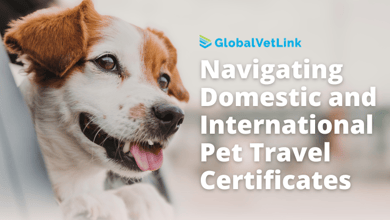Traveling with Pets: 10 Ultimate Tips to Consider

Table of Contents
1. Research travel requirements
2. Schedule a vet visit
3. Choose the right carrier
4. Familiarize your pet with the carrier
5. Practice short trips
6. Plan for comfort
7. Stock up on supplies before travel
8. Reduce stress safely
9. Check your pet's travel insurance
10. Consider if the trip is necessary
FAQs
It’s no secret that traveling mid to long distances can be tiring, stressful, and require much planning. Traveling with a pet adds a whole new dimension and parental worry!
If you’re considering traveling with your pet, we have all the information you need to help things go as smoothly as possible!
1. Research Travel Requirements
Whether you are traveling with a dog or cat by car or by plane, if you are crossing state or international boundaries, you need to be aware of the requirements of the territory you are traveling into.
Looking for an ideal place to travel with your dog? Check out "Most Dog Friendly States in America".
Many places have rules surrounding infectious diseases and may require pet vaccinations, blood tests before travel, and potentially parasite control.
Additionally, you may need a domestic or international pet travel certificate, which may need to be issued in a certain time frame before travel.
Lastly, always read the fine print to avoid issues such as rejection at a border or lengthy quarantine periods.
2. Schedule a Vet Visit
Airlines often require a ‘fit to fly’ certification from a veterinarian. However, a vet visit is also a good idea if you are traveling with dogs or cats in a car for long distances. Travel puts stress on your dog or cat that they may not be used to, and it is best to be fully aware of any potential health issues, especially in very young or old animals and in brachiocephalic (flat-faced) breeds.
Book your pre-travel examination with one of our friendly vets.
3. Choose the Right Carrier
For plane journeys, strict regulations dictate what sort of pet carriers are accepted. Traveling with a pet on a plane can be complicated, so if you are in any doubt, always double-check with the airline involved.
Considering how you will restrain your pet in a car is equally important. Are they reactive to moving objects? Would they be happier if you could cover their carrier with a blanket?
Safety is paramount, so consider how to prevent your cat or dog from distracting or interfering with the driver. It’s best to make sure your animal is properly secured. If you are traveling with a cat or your dog does not have a reliable “wait” command, consider how to stop them from escaping when the car is opened.
4. Familiarize Your Pet With the Carrier
Whether this is an airplane carrier or a wire crate that goes in the trunk of your car, ideally, the first time your cat or dog sees the carrier should not be just as they are embarking on a long journey. Desensitization to the carrier will go a long way towards making your pet feel at ease on their journey.
Have the carrier out around the house leading up to the journey, place a well-loved blanket or an item of your clothing in it, and feed your cat or dog treats in it to create a positive association. Teaching a dog to relax in a crate is an invaluable skill for which you will be grateful at various times in their life!
5. Practice Short Trips
Obviously, this isn’t possible when it comes to flying, and it may be harder to achieve with cats, but if you plan on traveling with dogs in a car long distance, it makes sense to do a few trial runs first. Short journeys with lots of positive reinforcement and encouragement can help them adapt to the process and be more relaxed when it comes to the main trip.
6. Plan For Comfort
Planning is essential when traveling with dogs and cats, especially if you’re traveling for a long distance. This includes making sure you are in the right place at the right time to drop your pet off or collect them from the airport. Try and plan as direct a flight path as possible, ideally at a time of day and year with the most pet-friendly temperatures.
When traveling with dogs in the car long distance, research accessible places to stop and provide toilet breaks and short walks. Even if you’re only traveling with a cat in the car, you’ll need to find places to stop and provide meals, especially if you’re traveling long distances. Consider where you are going to stop for your amenities so that you do not have to leave your pet unattended in the car.
7. Stock Up On Supplies Before Travel
Necessary supplies will vary somewhat depending on whether you are traveling with a cat or a dog, but consider chews, toys, food, water bowls, drinking water containers, coats, blankets, and any medications your pet may be taking. Offering enrichment or games up until the point of boarding can make traveling by plane easier on your pet; likewise, a well-timed play time can break up a long day on the road.
8. Reduce Stress Safely
Luckily, there are now an array of anxiety-busting tools out there for dogs and cats, including calming food, supplements, and pheromone-releasing products. Adaptil and Feliway are both well-established products that can ease stressful situations.
Anxious dogs traveling by car may benefit from wearing a ‘Thundercoat’, a weighted coat designed to offer physical reassurance to them. As ever, take care to monitor the temperature of the car whilst they are wearing this. Sedating your pet for travel is not normally a safe option, but you can discuss this with our vets if you think it’s necessary.
9. Check Your Pet's Travel Insurance
Yes, pet travel insurance is a thing! If you are holidaying with your pet, consider the costs of unexpected kennelling if plans went astray or the cost of treatment should your pet get sick whilst abroad.
10. Consider If the Trip is Necessary
If the above tips can’t mitigate the stress on your cat or dog, ask yourself if the journey is necessary or if there is an alternative. It can be difficult not to have your pet by your side, so if you are struggling to decide if the trip is right for them, please contact a veterinarian for assistance.
Conclusion
Before traveling with your pets, thoroughly plan, prepare, and consider their well-being. By following these ultimate tips, you can ensure a smoother, more enjoyable journey for both you and your furry companions. If you're unsure whether the trip suits your pet, consult our veterinary team to make an informed decision. Safe travels!
Frequently Asked Questions
Is traveling with a pet a good Idea?
Whether moving to a new city or going on a long break, sometimes traveling with your pets is necessary. But before you plan that big road trip with your pet, it’s a good idea to sit down and consider whether it’s the best option for your furry friend.
Some pets are just not suited to long journeys, whether by plane or car. Animals easily prone to stress, short-snouted (brachycephalic breeds), and larger dogs may not find traveling fun or comfortable. Consider all your options before deciding to travel with a dog on a plane or by car.
Can my pet fly in an airplane cabin?
In some cases, yes, depending on the size of your pet and the airline. Otherwise, your pet will need to travel in the cargo hold. This is an important point to explore if you have a brachiocephalic pet that may not regulate their body temperature, as well as some others may do.
Can I sedate my pet to travel?
It is not recommended to sedate pets for travel as it affects their body systems, and it is not possible to monitor them adequately. There are prescription medications that can help with anxiety. However, a veterinarian can help you decide if this is a good option for your pet when traveling.
How long can my cat or dog travel in a car?
This will depend largely on the age and temperament of your pet, but it is generally recommended to schedule a break every couple of hours or so.





